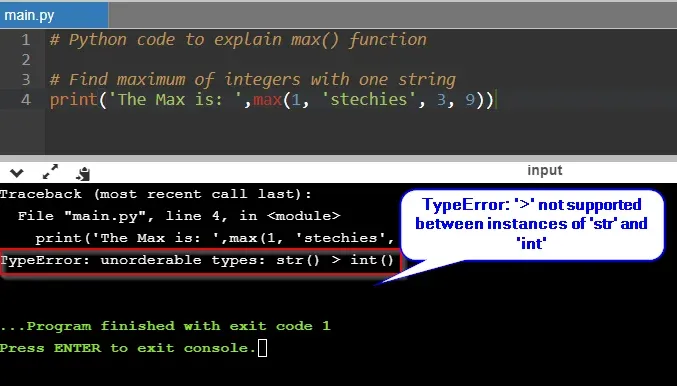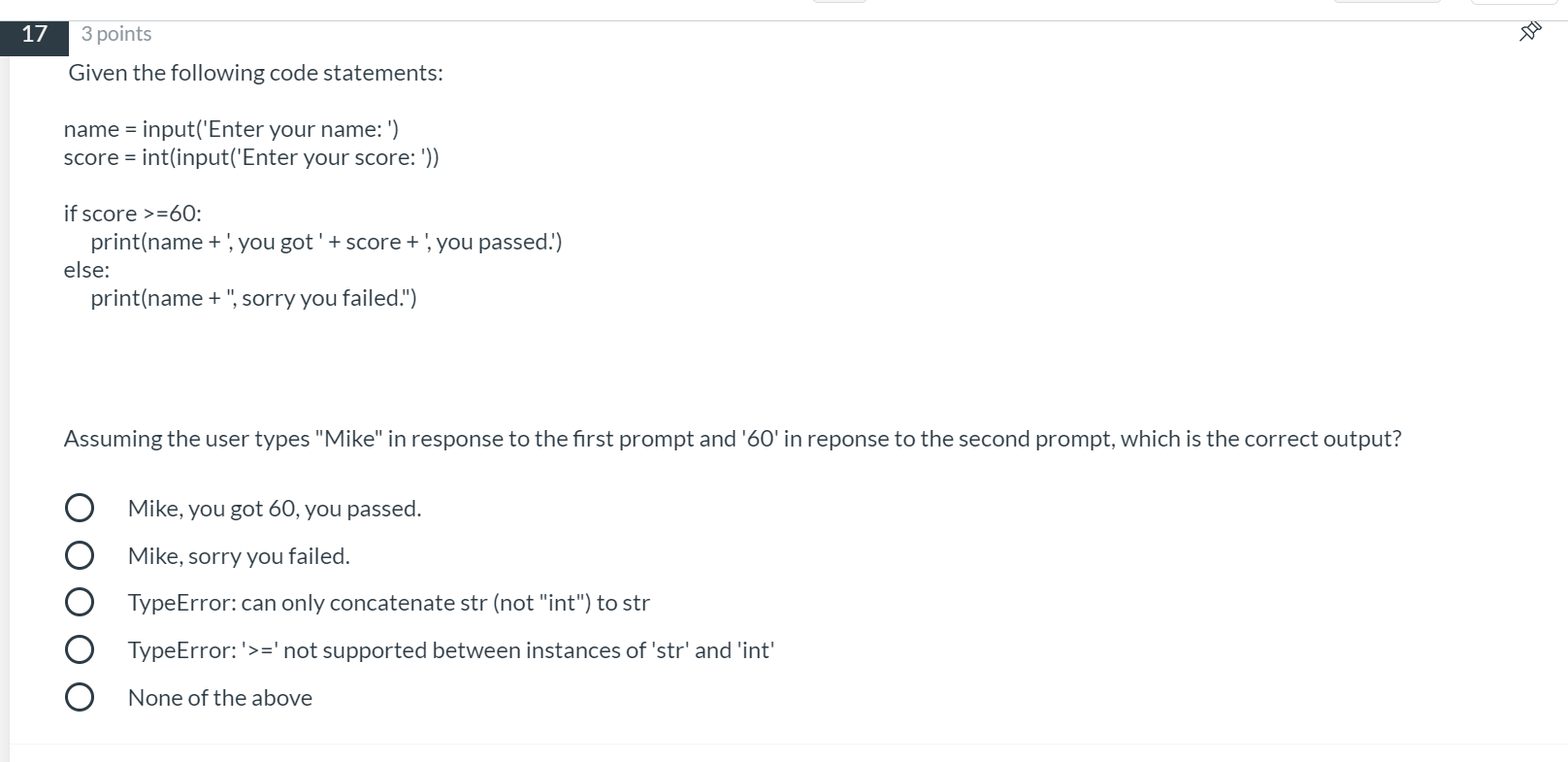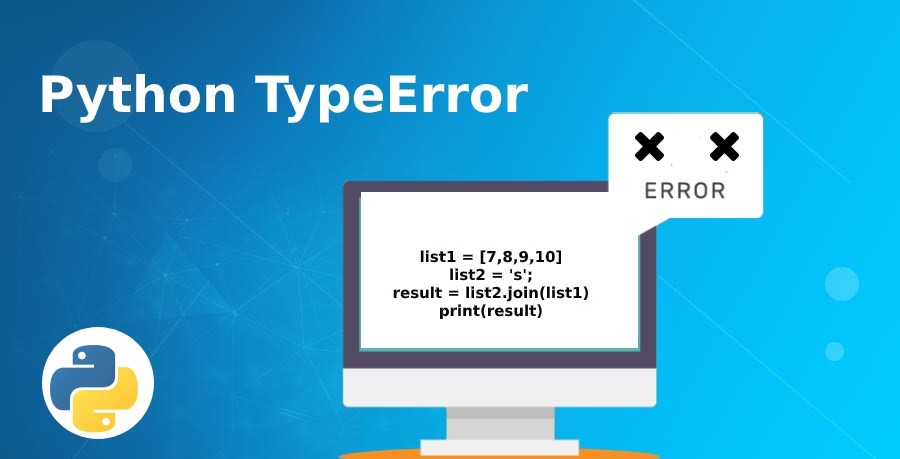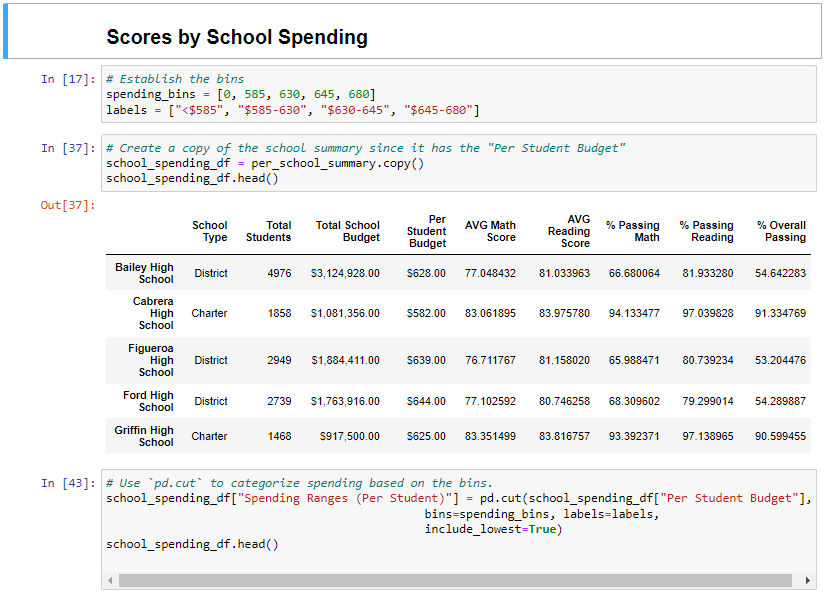Typeerror Not Supported Between Instances Of Str And Int
The TypeError “not supported between instances of str and int” is a common error message that occurs when trying to perform an unsupported operation between a string and an integer in Python. It indicates that the two data types are incompatible for the operation being performed.
Explanation of the error message:
In Python, different data types are used to represent different kinds of information. A string is a sequence of characters, enclosed in single or double quotes, used to represent textual data. On the other hand, an integer is a whole number, without any decimal or fractional part, used to represent numerical data.
When an operation is performed between a string and an integer, such as trying to concatenate them with a plus (+) operator, Python throws a TypeError because it does not have a predefined rule for combining these two data types. The error message “not supported between instances of str and int” indicates that the operation is not supported between these specific instances of string and integer.
Common scenarios where the error occurs:
1. Concatenation of a string and an integer:
When trying to combine a string and an integer using the plus (+) operator, the TypeError can be raised. For example:
“`python
x = “Hello” + 123
“`
2. Using a string as an index to access an element in a list or tuple:
If a string is used as an index value to retrieve an element from a list or tuple, Python raises a TypeError. For example:
“`python
my_list = [1, 2, 3, 4]
x = my_list[“index”]
“`
Understanding the difference between strings and integers:
Strings and integers are fundamentally different data types in Python. A string is a sequence of characters, while an integer is a numerical value. They have different properties and methods associated with them.
Conversion methods between string and integer types:
To convert a string to an integer, Python provides the `int()` function. For example, to convert the string “123” to an integer, you can use the following code:
“`python
x = int(“123”)
“`
To convert an integer to a string, Python provides the `str()` function. Here’s an example:
“`python
x = 123
str_x = str(x)
“`
Error resolution through explicit type conversion:
To resolve the TypeError, you can explicitly convert either the string or the integer to the desired type before performing the operation.
For example, if you want to concatenate a string and an integer, you can convert the integer to a string using the `str()` function:
“`python
x = “Hello” + str(123)
“`
Comparing and combining strings and integers:
To compare strings and integers, you need to explicitly convert them to the same data type before the comparison. This can be done using the conversion methods mentioned earlier.
For example, to compare a string and an integer numerically, you can convert the string to an integer first:
“`python
x = “123”
y = 123
if int(x) == y:
print(“Equal”)
“`
Best practices to avoid this type of error:
1. Always ensure that you are comparing or combining data types that are compatible. If necessary, use explicit type conversion to bring them to the same data type.
2. Validate user inputs to ensure they are of the expected data type before performing operations.
3. Follow proper naming conventions for variables to avoid confusion between different data types.
Troubleshooting and debugging techniques for this error:
When encountering the TypeError “not supported between instances of str and int”, it is essential to identify the specific line of code that caused the error. Here are some troubleshooting and debugging techniques to help resolve this error:
1. Use print statements to display the values of the variables involved in the operation to identify any unexpected data types.
2. Review the traceback error message to pinpoint the line of code that raised the TypeError.
3. Check if there are any implicit type conversions happening in the code that may be causing the error. Explicitly converting the data types involved can help resolve the issue.
FAQs:
Q: What other instances can raise the “not supported between instances of” TypeError?
A: The TypeError can occur with other data types as well, such as lists, methods, floats, and tuples. For example: “Not supported between instances of ‘list’ and ‘int'”.
Q: How can I convert a string to an integer in Python?
A: You can use the `int()` function to convert a string to an integer. For example: `x = int(“123”)`.
Q: Why do I get the “Invalid literal for int() with base 10” error?
A: This error typically occurs when trying to convert a string to an integer using the `int()` function, but the string contains characters that are not valid integer literals. For example, `int(“abc”)` would raise this error.
Fix Typeerror: ‘ ‘ Not Supported Between Instances Of ‘Dict’ And ‘Dict’ | (Troubleshooting #4)
What Is Message Not Supported Between Instances Of Str And Int?
Python is a versatile programming language that allows developers to work with various data types, including strings and integers. However, there are instances when an error message crops up, stating “TypeError: unsupported operand type(s) for +: ‘str’ and ‘int’.” This particular error arises when one attempts to concatenate a string with an integer using the ‘+’ operator. In this article, we will dive deep into the reasons behind this error, explore the scenarios that trigger it, and provide a few common solutions to deal with it.
Understanding the Error Message:
The error message “TypeError: unsupported operand type(s) for +: ‘str’ and ‘int'” is raised when you try to add (concatenate) a string with an integer. In Python, the ‘+’ operator is used for both addition and concatenation. However, these operations have different meanings depending on the types involved. When used with two integers, ‘+’ performs mathematical addition. But when one operand is a string and the other is an integer, it tries to concatenate them, assuming you want to combine both into a single string. Unfortunately, this operation is not supported by default in Python.
Scenarios that Trigger the Error:
Let’s consider some common scenarios that can lead to the “TypeError: unsupported operand type(s) for +: ‘str’ and ‘int'” error message:
1. Concatenating a string with an integer:
x = “Hello, I am ” + 25
In this example, we are attempting to concatenate the string “Hello, I am ” with the integer 25. However, since the operands are not of the same type, Python raises the TypeError.
2. Mixing string and integer variables:
num = 10
result = “The result is: ” + num
Here, we are trying to concatenate the string “The result is: ” with the variable ‘num’, which is an integer. Again, this leads to a TypeError since the operation is not supported.
3. Using an integer in a string format:
message = “The number is ” + str(42)
In this case, we want to concatenate the string “The number is ” with the integer 42. However, we need to convert the integer into a string using the ‘str()’ function to avoid the TypeError.
Common Solutions:
Now that we understand why the “TypeError: unsupported operand type(s) for +: ‘str’ and ‘int'” error occurs, let’s explore some common solutions to resolve it:
1. Convert the integer into a string:
If you want to concatenate a string with an integer, you need to convert the integer into a string using the ‘str()’ function. Example:
x = “Hello, I am ” + str(25)
2. Use string formatting:
String formatting allows you to combine strings with other data types without explicitly converting them. The ‘format()’ method can be used to achieve this. Example:
age = 25
sentence = “I am {} years old”.format(age)
3. Use f-strings (formatted string literals):
Python 3.6 introduced f-strings, which provide a concise and readable way to format strings. With f-strings, you can directly embed variables within curly braces for easy concatenation. Example:
num = 42
message = f”The number is {num}”
FAQs (Frequently Asked Questions):
Q1. Why does Python allow mathematical addition but not string concatenation between str and int?
A1. Python allows mathematical addition because it is a well-defined operation between two numerical values. String concatenation, on the other hand, is a more specific use case and requires explicit handling to avoid ambiguity. Hence, Python does not assume string concatenation when mixing string and integer types.
Q2. I want to perform mathematical addition with a string and an integer. How can I achieve that?
A2. To perform mathematical addition with a string and an integer, you need to convert the string into an integer using the ‘int()’ function. After the conversion, you can add the two integers together. Example: result = int(“10”) + 5
Q3. Will the “TypeError: unsupported operand type(s) for +: ‘str’ and ‘int'” error occur in other programming languages?
A3. The specific error message may differ, but in most programming languages, you would encounter a similar issue when trying to combine incompatible data types. The concept of concatenating a string with an integer is not supported by default in many programming languages.
Q4. Why does the error message mention the ‘+’ operator in particular?
A4. The error message mentions the ‘+’ operator because it applies to both mathematical addition and string concatenation. Python tries to determine the appropriate operation based on the types of the operands. However, when it encounters a string and an integer, it assumes concatenation, leading to the error.
How To Convert String To Integer In Python?
Python is a versatile and powerful programming language that offers numerous functionalities to developers. While working with Python, developers often come across scenarios where they need to convert a string into an integer. In this article, we will delve into the various methods available in Python to convert a string to an integer. We will explore their usage and discuss potential scenarios where each method can be applied.
Method 1: Using int()
The most straightforward and commonly used method to convert a string to an integer in Python is by utilizing the built-in int() function. The int() function takes a string as input and returns its corresponding integer representation. For example:
“`python
num_str = “123”
num_int = int(num_str)
print(num_int)
“`
This will output:
“`
123
“`
When used with the int() function, a string should contain only numeric characters. If the string contains non-numeric characters, such as letters or symbols, a ValueError will be raised. Therefore, it is crucial to ensure that the input string is valid before using int(). Otherwise, a validation mechanism should be implemented to handle such cases.
Method 2: Using ast.literal_eval()
Another approach to convert a string to an integer is by utilizing the ast.literal_eval() function. This function is part of the ast module and can evaluate strings containing valid Python literal structures, such as strings, numbers, tuples, lists, dictionaries, and booleans. Here is an example:
“`python
import ast
num_str = “456”
num_int = ast.literal_eval(num_str)
print(num_int)
“`
The output will be:
“`
456
“`
Unlike int(), ast.literal_eval() is more flexible and can handle different literal structures. However, it is important to note that it evaluates the entire string, which may make it less suitable for converting strings with additional characters or expressions.
Method 3: Using the map() function
The map() function can also be employed to convert a string to an integer. This method is particularly useful when dealing with multiple numbers within one string. The map() function takes two arguments: a function and an iterable object. It applies the given function to each element of the iterable and returns a map object, which can be converted to a list if desired. Consider the following example:
“`python
num_str = “789”
num_list = list(map(int, num_str))
print(num_list)
“`
This will output:
“`
[7, 8, 9]
“`
By using the map() function, each character in the string is converted into an integer, resulting in a list of integers. This approach is particularly useful when dealing with numeric values that are provided as a concatenated string.
Method 4: Using the ord() function
In some cases, it might be necessary to convert a string consisting of a single character to its corresponding ASCII value representation. Python allows this by using the ord() function. Here is an example:
“`python
char = ‘A’
ascii_val = ord(char)
print(ascii_val)
“`
The output will be:
“`
65
“`
The ord() function returns the ASCII value of the character provided in the input string. This method is useful when working with character-based operations or when the ASCII value is necessary for further processing.
FAQs:
Q1. What happens if I use int() on a string that contains non-numeric characters?
A1. If the string passed to int() contains non-numeric characters, a ValueError will be raised. It is essential to validate the input string before using int() to avoid such errors.
Q2. Can I convert a floating-point number string to an integer?
A2. Yes, you can use int() to convert floating-point strings to integers. However, keep in mind that int() will truncate the decimal portion of the number, effectively rounding down to the nearest whole number.
Q3. Is there a limit on the size of the string that can be converted to an integer?
A3. The maximum string size that can be converted to an integer depends on the machine’s memory and the Python implementation being used. In most cases, the limit is quite large, so you should not encounter any issues with common string sizes.
Q4. Can I use these methods to convert a string to a different numeral system, such as hex or binary?
A4. The int() function can convert string representations of different numeral systems to their respective integer values. For example, int(“FF”, 16) will convert the string “FF” to its hexadecimal integer equivalent.
In conclusion, Python offers multiple approaches to convert a string to an integer, each suitable for different scenarios. By understanding and utilizing these methods, developers can effectively convert strings to integers and enhance their problem-solving capabilities within the Python programming language.
Keywords searched by users: typeerror not supported between instances of str and int Not supported between instances of ‘list’ and ‘int, Not supported between instances of ‘method’ and ‘int, TypeError not supported between instances of, Not supported between instances of ‘float’ and ‘str, Not supported between instances of tuple and int, Convert string to int Python, Parseint Python, Invalid literal for int() with base 10
Categories: Top 68 Typeerror Not Supported Between Instances Of Str And Int
See more here: nhanvietluanvan.com
Not Supported Between Instances Of ‘List’ And ‘Int
In the world of programming, one may come across various types of errors that can be cumbersome to troubleshoot and fix. One such error often encountered by Python developers is the “TypeError: unsupported operand type(s) for +: ‘list’ and ‘int’.” This error message is quite self-explanatory, indicating that an operation involving a list and an integer is not supported. In this article, we will delve deeper into this error, discussing its causes, common scenarios, and potential solutions.
Causes of the Error:
The primary cause of this error is an attempt to perform unsupported operations between a list and an integer. In Python, lists are a versatile and dynamic data structure, allowing the storage of multiple values within a single variable. On the other hand, an integer is a primitive data type representing whole numbers. Performing addition, subtraction, or certain other arithmetic operations between these two types is not supported by default.
Common Scenarios:
1. Concatenating Lists and Integers:
One typical scenario where this error occurs is when trying to concatenate a list and an integer using the ‘+’ operator. For instance:
code:
my_list = [1, 2, 3]
result = my_list + 4
This code snippet would raise the “TypeError: unsupported operand type(s) for +: ‘list’ and ‘int'” error since the ‘+’ operator is not defined for merging a list and an integer.
2. Indexing with an Integer:
Another common mistake that triggers this error is when trying to access elements in a list using an integer as an index. In Python, indexing starts at 0, so an attempt to access, for instance, my_list[3] would raise this error if the list has fewer than 4 elements.
Solutions:
1. Explicit Casting to a List:
If you intended to combine an integer with a list, you need to explicitly cast the integer into a list before performing any operations. Here’s an example:
code:
my_list = [1, 2, 3]
result = my_list + [4]
By wrapping the integer 4 in brackets [], we create a single-element list, enabling us to concatenate it with the existing list.
2. Modifying the Data Structure:
If you find yourself encountering this error while working with lists and integers, it might be a sign that you’re attempting something that contradicts the intended data structure. Assess your code and consider alternatives like using separate lists or taking advantage of Python’s more suitable data structures, such as dictionaries or sets.
FAQs:
Q1. Can I perform other operations between lists and integers?
A1. Yes, certain operations, such as multiplying a list by an integer, are supported. The ‘+’ operator should only be used for concatenation between two lists.
Q2. Is there a way to add an integer to each element of a list?
A2. Yes, it is possible through list comprehension. For instance, if you have a list of numbers ‘my_list’ and want to add 5 to each element, you can use the following code:
code:
my_list = [1, 2, 3]
modified_list = [num + 5 for num in my_list]
This will produce the list [6, 7, 8].
Q3. Can this error occur with other data types?
A3. Yes, similar errors can occur when attempting to perform unsupported operations between different data types. It is essential to thoroughly understand the compatibility of data types and available operations in the programming language you’re using.
In conclusion, encountering the “TypeError: unsupported operand type(s) for +: ‘list’ and ‘int'” error is a common stumbling block faced by programmers, particularly those working with Python. Understanding the causes, common scenarios, and possible solutions discussed in this article will help you troubleshoot and resolve this error more effectively. Remember to always consider the intended data structures and data types when performing operations to avoid such errors.
Not Supported Between Instances Of ‘Method’ And ‘Int
When programming in any language, you may encounter various error messages that can sometimes be confusing, especially if you are a beginner. One such error message that often leaves programmers scratching their heads is “TypeError: unsupported operand type(s) for +: ‘method’ and ‘int'”. This error typically occurs when attempting to perform an operation between an instance of a method and an integer in the English programming language.
In this article, we will explore this error message in detail, explaining why it occurs, common scenarios where it arises, and provide some steps to resolve it. So, let’s dive in and unravel the mystery behind the “unsupported operand type(s) for +: ‘method’ and ‘int'” error.
Understanding the Error Message:
To comprehend this error, it is crucial to understand what the terms in the error message mean.
1. ‘TypeError’: This informs us that the error belongs to the category of type errors. Type errors occur when an operation is applied to an object of an inappropriate type.
2. ‘unsupported operand type(s)’: This indicates that the operation being performed (in this case, addition with the ‘+’ operator) is not compatible between the operand types provided.
3. ‘method’ and ‘int’: ‘method’ refers to a type of object in which behavior is encapsulated (also known as a function), while ‘int’ refers to an integer.
Common Scenarios for the Error:
The “unsupported operand type(s) for +: ‘method’ and ‘int'” error can occur due to various reasons. Let’s discuss some common scenarios where this error might arise:
1. Incorrect Method Call:
One common reason for this error is mistakenly calling a method without adding the parentheses after the method name. When parentheses are missing, the method reference is treated as a method object, rather than the result of calling the method. This can lead to the error when trying to perform an operation, such as addition, between the method object and an integer.
2. Incorrect Usage of Method Return Value:
If a method returns a value and you attempt to perform an operation directly on the method’s return value instead of assigning it to a variable, the error can occur. For example, let’s say you have a method that calculates the sum of two integers, but you forget to assign the return value to a variable before performing an addition operation on it.
3. Incorrect Placement of Parentheses:
Another cause for this error is placing parentheses incorrectly. For instance, if parentheses are misplaced and surround the entire expression, including the method call, it can result in the error.
Resolving the Error:
Now that we have explored the reasons behind the “unsupported operand type(s) for +: ‘method’ and ‘int'” error, let’s discuss some steps to resolve it:
1. Check Method Call:
Ensure that you are correctly calling the method by including parentheses after the method name. For example, if the method is named “calculate_sum()”, make sure you call it as “calculate_sum()”.
2. Use Method Return Value Appropriately:
If the method returns a value that you want to operate on, assign the return value to a variable first, before performing any operations on it. This way, you can reference the variable in subsequent computations instead of the method itself.
3. Verify Parenthesis Placement:
Make sure the parentheses are correctly placed around the intended expressions. Be mindful of any additional parentheses that may have been inadvertently included, causing the error.
Common FAQs:
Q1: Can this error occur in other programming languages?
A1: Yes, this error can occur in other programming languages as well. However, the specific error message may vary depending on the language used.
Q2: Does this error only apply to addition operations?
A2: No, this error can occur with other operations as well, such as subtraction, multiplication, or division. The specific error message may reflect the relevant operation.
Q3: Is this error exclusive to using methods and integers?
A3: No, this error can occur when attempting operations between incompatible operand types in general, such as between strings and integers or between different types of objects.
In conclusion, the “unsupported operand type(s) for +: ‘method’ and ‘int'” error is a common obstacle encountered while programming in English. Understanding the reasons behind this error and following the steps provided can help you avoid or resolve it. So, the next time you stumble upon this error message, you’ll be equipped to tackle it with ease. Happy coding!
Typeerror Not Supported Between Instances Of
In Python, a TypeError occurs when an inappropriate operation is performed on incompatible data types. One common TypeError that programmers encounter is the “TypeError: unsupported operand type(s) for +: ‘int’ and ‘str'”. This error message arises when you attempt to concatenate a string with an integer using the “+” operator. In this article, we will delve deeper into the reasons behind this error and explore ways to resolve it.
Understanding the TypeError
TypeError is an exception that occurs when an operation is performed on objects of incompatible types. The error message specifies the unsupported operand types involved in the operation. The TypeError we are addressing here arises when we attempt to concatenate a string and an integer. This error often arises when we are working with string concatenation, for example:
“`python
age = 25
message = “I am ” + age + ” years old.”
“`
Explanation of the Error
Python is dynamically typed, meaning that the type of a variable is determined at runtime. In the example above, the variable “age” is assigned an integer value of 25. However, when we try to concatenate it with the string “I am ” using the “+” operator, Python throws a TypeError. This is because the “+” operator for strings is defined to concatenate two strings, but not a string and an integer.
Python interprets the expression “I am ” + age + ” years old.” from left to right. The first operand is a string, so the next step would be to concatenate it with the second operand, which is an integer. However, since concatenation isn’t defined between a string and an integer, Python raises a TypeError.
Resolution
To resolve this TypeError, we need to ensure that both operands are of the same type. In this case, we need to convert the integer to a string before concatenating it with the other string:
“`python
age = 25
message = “I am ” + str(age) + ” years old.”
“`
In the code snippet above, we have used the str() built-in function to convert the integer variable “age” to a string. Now, both operands for the “+” operator are strings, avoiding the TypeError.
Alternatively, we can make use of formatted string literals, also known as f-strings, introduced in Python 3.6. With f-strings, we can directly embed variables within a string without explicitly converting the types:
“`python
age = 25
message = f”I am {age} years old.”
“`
In the example above, the variable “age” is encapsulated within curly braces {} inside the string. Python automatically converts the integer to a string, resulting in a concatenated message.
Frequently Asked Questions (FAQs):
Q: Can a TypeError occur with other operands and data types?
A: Yes, a TypeError can occur with various operands and incompatible data types. For instance, attempting to perform mathematical operations between incompatible types like strings and floats, or even lists and integers, can result in a TypeError.
Q: How can I identify the line causing the TypeError?
A: The error message indicates the line number where the TypeError is encountered. Review the traceback to determine the line causing the error and examine the code for potential type incompatibilities.
Q: Can the TypeError be raised in comparison operators?
A: Yes, a TypeError can also arise during comparison operations between incompatible types. For instance, comparing an integer and a string using the “==” operator will raise a TypeError.
Q: What other Python built-in functions can help handle type conversion?
A: Apart from the str() function, other built-in functions such as int(), float(), and bool() can be used for type conversion, depending on the desired data type.
In conclusion, the TypeError: unsupported operand type(s) for +: ‘int’ and ‘str’ occurs when attempting to concatenate a string and an integer. By converting the integer to a string or using f-strings, we can overcome this error. Understanding the TypeError and the ways to resolve it will help programmers write error-free code and facilitate smooth program execution.
Images related to the topic typeerror not supported between instances of str and int

Found 32 images related to typeerror not supported between instances of str and int theme






![Solved 1. [2 marks] Explain the meaning of the error message | Chegg.com Python - Pandas Merge Error Typeerror: '>‘ Not Supported Between Instances Of ‘Int’ And ‘Str’ – Stack Overflow” style=”width:100%” title=”python – Pandas merge error TypeError: ‘>’ not supported between instances of ‘int’ and ‘str’ – Stack Overflow”><figcaption>Python – Pandas Merge Error Typeerror: ‘>’ Not Supported Between Instances Of ‘Int’ And ‘Str’ – Stack Overflow</figcaption></figure>
<figure><img decoding=](https://i.stack.imgur.com/hkx73.png)












Article link: typeerror not supported between instances of str and int.
Learn more about the topic typeerror not supported between instances of str and int.
- TypeError: < not supported between instances of str and int
- TypeError: ‘<=' not supported between instances of 'str' and 'int'
- ‘>’ not supported between instances of ‘str’ and ‘int’ | sebhastian
- Convert String to int in Python – Scaler Topics
- ‘>’ not supported between instances of ‘str’ and ‘int’ | sebhastian
- Python TypeError: < not supported between instances of str ...
- Not supported between instances of str and int in python – TAE
- ‘>’ not supported between instances of ‘str’ and ‘int’
- Typeerror Not Supported Between Instances of Str and Int
- Solve typeerror not supported between instances of str and int …
- Typeerror: ‘>’ not supported between instances of ‘str’ and ‘int’
- TypeError: ‘>’ not supported between instances of … – STechies
See more: nhanvietluanvan.com/luat-hoc